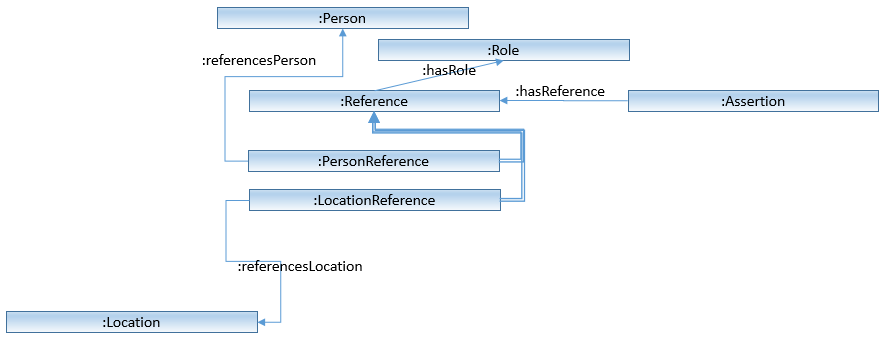FPO References
In the factoid prosopography model, Reference objects perform two possible functions: they connects factoids to either the historical persons or geographic locations involved in them. As the diagram below shows, all references are connected to assertions / factoids, and are either Person References, in which case they link to a Person, or they are Location References, in which case they link to a Location. A role can be assigned to the reference: a role being a mechanism by which the entities function within the assertion/factoid can be asserted. For instance, in a transaction someone might be given the role of "grantor". A reference is connected to a particular spot in a source where a name for the person or place is written. Thus, both kinds can also have a property that records how the person or location’s name was recorded in the source at that point where they are mentioned for the factoid.

(NB: It is in the classes associated with References that the most significant changes have happened between this version of the FPO, and the original published version 0.1).
Classes
- :Reference: In the factoid prosopography model, a :Reference item links an assertion / factoid to a person or a geographic location. As well as providing the link between the factoid and person, it also provides a place that can capture information about the particular spot in the source where the person or location is named, in particular how the name is written, and what their role was in the factoid.
- :PersonReference: References that link to persons are :PersonReferences.
- :LocationReference: References that link to geographic locations are :LocationReferences. Several CCH/DDH projects subclassed :LocationReference to allow them to specify a role for the geographic location in a factoid.
- :Role: The :Role class says something about the nature of the involvement of the person or location within the factoid. For factoids that normally have only a single person reference (e.g. :OfficeFactoid) the role is not really required (although CCH/DDH projects tended to assign a generic role of “primary” in this case). However, when there is more than one person involved in a factoid, the role can be used to assert the character of their involvement For :RelationshipFactoid, for example, where 2 people are involved (e.g. “A is son of B”), CCH/DDH projects assigned the reference for A as having the “primary” role, and B as having the “secondary” role. A further example: for :Transaction factoids, one reference to a person would assert that s/he was the “grantor”, and another reference would assert that s/he wa the “beneficiary”. In CCH/DDH projects, roles were only used with :PersonReference, and were not apparently needed for :LocationReference.
Properties
The main function of the :Reference is to connect factoids to persons or geographic locations. Thus, they primarily carry information in their relationships, described below. However, they also provide an object that represents a person or location in a particular factoid, and therefore in a particular spot in a particular text. Thus, they also have a property that allows the name, as it appears there, to be recorded.
- :hasNameInSourceAs (for :Reference:) provides a text string where the name for the person or geographic location, as it appears in the source, can be recorded. CCH/DDH project allowed only one name to be attached to each reference, and this has proven to be sufficient for all the projects.
:hasRoleName (for :Role): As should be clear from the discussion above, the roles associated with a references comes in different types: primary, secondary, grantor, beneficiary, etc. CCH/DDH project did this by creating multiple instance of the :Role class and assigning each instance a name using :Role’s :hasRoleName property. Alternatively, one might create subclasses of :Role for each type needed.
Relationships
The following relationship properties are defined in FPO for the :Reference set of classes:
- :hasReference (from :Assertion to :Reference): provides the path (via references) through which the person or persons associated with the assertion are defined, or geographic relationships are provided for an assertion / factoid. Note that CCH/DDH practice allowed more than one person to be linked to a single assertion / factoid, but each :Reference should have only on :hasReference link from a particular assertion / factoid.
- :referencesPerson (from :PersonReference to :Person): :referencesPerson is the mechanism used to link, through :Reference, a factoid to a person with which it is associated. Any number of :referencePerson statements (and therefore factoids) can be linked to a particular :Person, but CCH/DDH practice had each :PersonReference link only to one :Factoid and one :Person.
- :referencesLocation (from :LocationReference to :Location): :referencesLocation is the mechanism used to link, through a :LocationReference, a factoid to a geographic location with which it is associated. Any number of :referencesLocation statements (and therefore factoids) can be linked to a particular :Location, but CCH/DDH practice had each :LocationReference link to only one :Factoid and one :Location.
- :hasRole(from :Reference to :Role): associates a :Role to a the Reference: asserts, for this Reference, the role of the person or location in the factoid. In CCH/DDH projects :hasRole is functional (in the OWL sense): only one Role is assigned to any Reference.